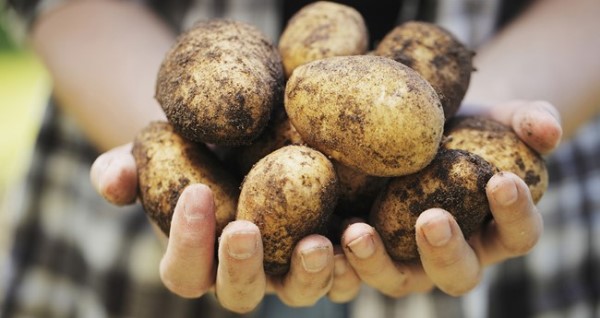Potato Seed Treatments
10 December 2021The 2021 potato seed crop has been in store for several months, but with some stocks being graded for export it’s timely to review management options for seed treatments.
It is important to take an integrated approach to crop management and to assess each stock on a case-by-case basis. Excellent general guides are available online such as the AHBD Store Manager’s Guide and Certis’ Tubercare website.
Risk Assessment
Growers should carry out a risk assessment on their stocks to decide on appropriate action. However, there are some general principles that are important no matter the variety or the disease pressure:
- Excellent store hygiene is an absolute prerequisite for healthy stocks.
- Handle tubers as little as possible and take care to avoid damage.
- Keep crops dry: ventilate and avoid condensation.
- Keep a close eye on store temperature.
Some key considerations for assessing risk are:
What is the variety’s disease resistance rating? Use an objective source such as the AHDB potatoes variety database. If the susceptibility rating (resistance score) is low, consider a fungicide treatment.
Is the variety prone to damage during handling or is there any evidence of damage? Varieties with longer more elongated tubers are more susceptible to damage when harvested and handled. Damage, bruises, wounds and skin splitting can all lead to the ingress of disease through contact of disease inoculum on vulnerable exposed tuber flesh. If damage is more than normal or skin set is poor, apply a fungicide seed tuber treatment.
Was disease present on the planted mother tubers? Diseases like gangrene, dry rot, and skin spot are difficult to eradicate once established in a stock. Even low levels in planted seed can cause severe disease in the harvested crop.
Does the farm have a history of particular disease issues? If so, routine treatment may be required to suppress the disease.
Is the stock late harvested? Late harvest increases the risk of most diseases except dry rot.
Are the conditions at harvest wet? Wet harvest conditions make drying the crop more difficult and conditions favourable for infection, particularly by skin spot and silver scurf. If a crop is low risk good hygiene and store management will be sufficient to prevent harmful losses due to disease, there is little point using a seed treatment where it is not needed. Some issue may become apparent at grading, if so the available seed treatments, which are protectants may limit spread but will not turn back the clock.
Storage seed treatments
There are two products which can be used on seed potatoes in Great Britain: Gavel (imazilil) and Storite Excel (thiabendazole). Details of both can be found in the follow table. If you intend to use these products, the best time is within 48 hours of harvest. Check product labels and seek advice from a BASIS qualified agronomist. Some disease will not be controlled or reduced by treatment; these include bacterial soft rotting and black dot (Colletotrichum coccodes).
| Fungicide | Active ingredient | Label claims |
| Gavel
| Imazilil | Silver surf (reduction) Skin spot (reduction) Gangrene Dry rot* |
| Storite Excel | Thiabendazole | Silver scurf* (reduction) Skin spot* (reduction) Gangrene (reduction) Dry rot* (reduction) |
* Possible resistance issues have been reported in the past – current situation is not fully known.
Pre-planting treatments
Many growers will be planning ahead and considering treatment pre-planting. This has a different objective to storage treatments. The propose of a pre-planting treatment is to reduce the risk from seed-borne inoculum and to protect daughter tubers.
As with storage treatments, a risk-based approach is most appropriate. Not all crops will require a seed treatment. Inspect seed stocks and note diseases present. It’s also vital to consult field records for details such as length of rotation and occurrence of issues in previous crops. Check product labels and with your customers for restrictions on use. Options are summarised in the following table:
| Fungicide | Active ingredient | Label claims for progeny |
| Gavel
| Imazilil | Silver surf (reduction)* Skin spot (reduction)* |
| Maxim 100FS | Fludioxonil | Black scurf Silver scurf (reduction) Black dot (reduction) |
| RhiNo
| Flutolanil | Black scurf
|
| RhiNo DS
| Flutolanil | Black scurf
|
| Honesty†
| Fluxapyroxad | TBA (Black scurf + others) |
| Serenade ASO
| Bacillus amyloliquefaciens | Silver scurf (reduction) |
* When used as a pre-planting treatment
† Newly approved in 2021. Expected to be launched in 2023.
Most pre-planting seed treatments are applied to reduce the incidence and severity of Rhizoctonia (which can cause black scurf amongst other issues). It is important to remember that seed treatments will have little effect against soil-borne Rhizoctonia and other management strategies should be used.
Whenever you apply a seed treatment application and stewardship are crucial. Poor application will lead to poor results, and seed treatment when unnecessary is wasteful.
- Only treat stocks following a risk assessment
- Regularly calibrate equipment
- Results will be best when tubers are dry
- Heavy soil loading will hamper treatment
Dr Kyran Maloney, Potato Consultant, SAC Consulting
Sign up to the FAS newsletter
Receive updates on news, events and publications from Scotland’s Farm Advisory Service

